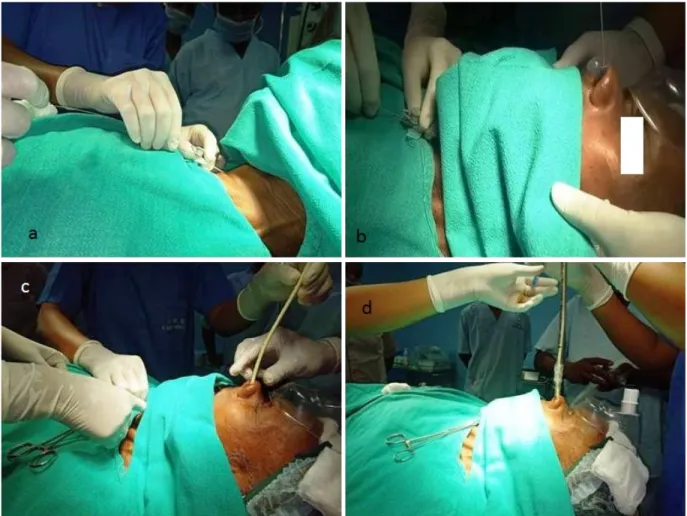http://www.jdapm.org 315
Letter to the Editor pISSN 2383-9309❚eISSN 2383-9317
J Dent Anesth Pain Med 2018;18(5):315-317❚https://doi.org/10.17245/jdapm.2018.18.5.315
Revisiting the awake retrograde nasal intubation technique
Bhavna Sriramka, Diptimayee Mallik, Megha Khetan, Nupur Moda
Department of Anesthesia and Critical care, IMS & SUM Hospital, Bhubaneswar, Odisha, India
Keywords: Awake; Nasal Intubation; Retrograde.
This is an Open Access article distributed under the terms of the Creative Commons Attribution Non-Commercial License (http://creativecommons.org/licenses/by-nc/4.0/) which permits unrestricted non-commercial use, distribution, and reproduction in any medium, provided the original work is properly cited.
Received: October 1, 2018•Revised: October 9, 2018•Accepted: October 10, 2018
Corresponding Author:Bhavna Sriramka, Department of Anesthesia and Critical care, IMS & Sum Hospital, Bhubaneswar, 106 Mahadev Orchid, Cosmopolis road Dumduma, Bhubaneswar 751019, Odisha, India
Tel: +919090471731 E-mail: bhavna.sriramaka@gmail.com Copyrightⓒ 2018 Journal of Dental Anesthesia and Pain Medicine
Sir,
Retrograde intubation is an important rescue technique in difficult airway situations where flexible fibreoptic bronchoscopes are unavailable or there is a lack of skilled personnel. However, it is a blind procedure and is often associated with complications such as nasal bleeding, subcutaneous emphysema, and failure to retrieve through the nose [1]. Risk of epidural catheter coiling due to the thin pliable design and occasional ethmoidal perforation with cerebrospinal fluid leak, has also been reported [2, 3]. Here, we describe a novel modification to the existing procedure that makes it simpler for the anesthetist and safer for the patient. A 68-year-old, ASA I male, with carcinoma of the buccal mucosa, was scheduled to undergo wide local excision. His mouth opening was one finger with no restriction of neck movements. In the absence of the fibreoptic bronchoscope, awake retrograde nasal intubation was planned. The procedure was explained and an informed consent was obtained. Pre-medication with intravenous (IV) glycopyrrolate 10 mcg/kg, mida- zolam 0.03 mg/kg, fentanyl 1 mcg/kg was carried out, and 4% lignocaine was used for nebulization. Oxymeta- zoline drops (0.5% w/v) were instilled in the nasal cavity
after patency check. Superior laryngeal and glossopharyn- geal nerve blocks (extra oral technique) were admini- stered bilaterally. A nasopharyngeal airway of size 32 was inserted in the left nostril inline and secured. Under local infiltration, the cricothyroid membrane was pierced with a 16-gauge (G) IV cannula. The needle was removed following lack of resistance and the placement of cannula was confirmed with air aspiration; further intra-tracheal local infiltration was carried out subsequently. A J-tipped guide wire (Certofix, B. Braun) was inserted by Sel- dinger’s technique with its straight end through the 16-G cannula (Fig. 1a). The guide wire was gently pushed until it was retrieved through the nasopharyngeal airway (Fig.
1b) and maximally pulled until it could be held by a hemostat at the cricothyroid end. The nasopharyngeal airway was removed and a Cook’s airway exchanger was inserted over it (Fig. 1c). A cuffed flexo-metallic endo- tracheal tube (ETT) of internal diameter 7 mm was rail-roaded through it finally (Fig. 1d). The guide wire and airway exchanger were then removed, and the ETT was inserted to a mark of 25, where the bilateral air entry was auscultated, as confirmed by capnograph, and fixed.
Anesthesia was induced with IV propofol 2 mg/kg and
Bhavna Sriramka, et al
316 J Dent Anesth Pain Med 2018 June; 18(5): 315-317
Fig. 1. (a) The 16-gauge IV cannula (after the needle has been removed) used to pass the straight end of the “J tipped” guide wire, (b) Retrieval of the guide wire through the nasopharyngeal airway, (c) The tube exchanger being passed over the guide wire, (d) Passing of the endotracheal tube railroaded over the tube exchanger.
vecuronium 0.1 mg/kg and maintained with oxygen, nitrous oxide, and isoflurane. At the end of surgery, IV neostigmine 0.05 mg/kg and glycopyrrolate 10 mcg/kg were used for reversal, and the patient was transferred to the intensive care unit for observation. The patient was extubated after 24 h uneventfully.
In difficult airway scenarios, the non-availability of fibreoptic bronchoscopes further complicates the situation.
Retrograde nasal intubation, first described by Water in 1963, is a boon to overcome such problems, and is a
‘must learn’ bailout procedure for all trainee anesthetists [4]. Nevertheless, this procedure is associated with a few iatrogenic complications such as an inadvertent puncture of the posterior tracheal wall or esophagus, and failure to retrieve the wire through the nose [1]. We made simple modifications such as using the 16-G IV cannula to pass
the guide wire in place of the needle itself or the Tuohy needles. This prevents any inadvertent injury to the posterior tracheal wall during local anesthetic instillation or guide wire insertion. The nasopharyngeal airway walls off the nasopharyngeal space and acts as a perfect conduit for the guide wire. The retrieval of the guide wire is also easy and prevents any injury to the nasal cavity by its pointed ends or catheter malpositioning. This novel adaptation of the retrograde intubation technique is hence safer for the patient and simpler for the anesthetist.
AUTHOR ORCIDs
Bhavna Sriramka: https://orcid.org/0000-0001-8439-5908 Diptimayee Mallik: https://orcid.org/0000-0003-0616-8157 Megha Khetan: https://orcid.org/0000-0002-1830-1640 Nupur Moda: https://orcid.org/0000-0003-1008-8694
Revisiting retrograde nasal intubation
http://www.jdapm.org 317 NOTE: There are no financial or other issues that might
lead to conflict of interest.
REFERENCES
1. Loh K, Irish J. Complications of Endotracheal Intubation and Other Airway Management Procedures. Anesth Clin
North Am 2002; 20: 953-69.
2. Gerenstein RI. J-wire facilitates translaryngeal guided intubation. Anesthesiology 1992; 76: 1059.
3. Raval C, Patel H, Patel P, Kharod U. Retrograde intubation in a case of ankylosing spondylitis posted for correction of deformity of spine. Saudi J Anaesth 2010; 4: 38-41.
4. Waters DJ. Guided blind endotracheal intubation: For patients with deformities of the upper airwav. Anaesthesia 1963; 18: 158-62.
